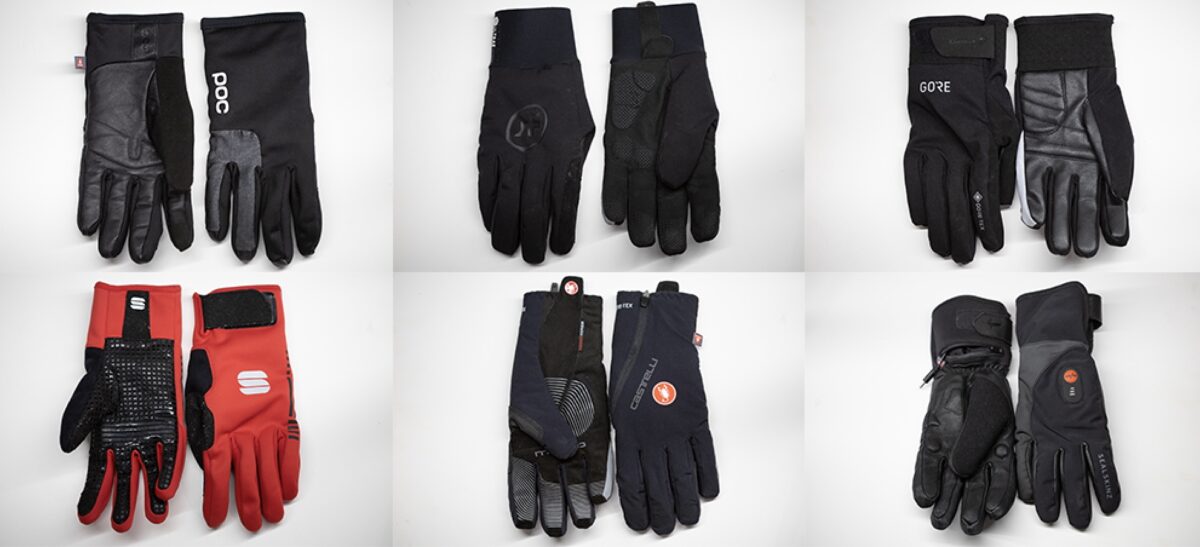
(Photos: Josh Ross/BikePortland)
Everyone wants the magic glove that will keep them warm as they spend hours in the rain and cold that defines Portland winter riding.
Sorry to be the bearer of bad news, but it doesn’t exist.
No matter what a company claims, no glove I have experienced will keep you dry for more than a couple of hours
I get a lot of questions about winter cycling gloves, and despite trying lots of options I don’t think there is a definitive answer. No matter what a company claims, no glove I have experienced will keep you dry for more than a couple of hours. When I head out for a big ride (and for me, “big” is like seven hours of riding time) this time of year, I expect to need at least four pairs of gloves. That equates to about one pair of gloves for every hour and 45 minutes of riding.
In this review, I’ll take a closer look at six different five-finger winter gloves I’ve tested that range in price from $80-$100. Unlike some of my reviews, I won’t pick a best option because none of these stand out as a clear winner. And at the end, I’ll share a roundup of some other options.
POC Thermal – $90
The POC Thermal uses a faux leather palm with no silicone grip material and only very light padding below the knuckles. They have touchscreen compatibility on the first finger and thumb tips. There’s no closure system at the cuff and even though you might not notice the pull tab, it’s integrated into the cuff in the form of a center section of the faux leather. The selling point of these is visibility with a very bright orange color available and a large section of reflective material covering the back of the outside two fingers.
Assos Ultraz Winter – $125
For the Assos Ultraz Winter glove (my photo is an older version, but the new one isn’t that different), Assos uses their own fabric technology. It’s a softshell membrane that’s not so different from Gore-Tex. The palm is faux suede with padding at the ulnar nerve and a good amount of silicone grip material. The cuff is long with an unfinished edge but there are two different pull tabs to get them on. I’m a huge fan of Assos winter gear but I don’t recommend paying the premium for these given the performance is not any different from less expensive options.
Advertisement
Gore Wear C5 Gore-Tex Thermo – $95
The C5 from Gore keeps its underlying technology a secret, but I do know that the “Gore-Tex” branding is their waterproof line and “Infinium” is their warmer, non-waterproof, version. The feature that stands out on the C5 is that the exterior is harder-wearing. The palm is a faux leather and the upper is the hardest fabric in the bunch. In the palm you do get a bit of padding at the ulnar nerve and at the base of the knuckles, but you don’t get touchscreen compatibility. The closure system is hook-and-loop with the hook side on the flap. There’s no pull tab at the wrist. These often go on sale, so if you can find a deal then you get similar performance for less money.
Sportful Sottozero – $80
Sportful has the Sottozero and the Fiandre glove and the marketing says the cold performance is similar, but the Fiandre has better wet weather performance. I have both gloves but I don’t agree with that assessment. The Sottozero is warmer and they both soak through, so enjoy the warmth while it lasts! What’s nice about Sportful gloves in general is that they love to use lots of silicone grip on the palm. It’s a joy to hold the controls and these have touchscreen compatibility too. The closure system is hook-and-loop but this time the hook is attached to the immobile side. The closure is also tenacious and you’ll end up using your teeth. There is an integrated pull tab in the cuff and the color options are nice if you want a bit of style in your gloves.
Castelli Espresso GT – $120
These Castelli Espressos actually stand out from the crowd a little. It’s subtle, so it’s tough to say it’s worth the extra money, but they do last just a little bit longer than other options on this list. It’s the same Gore-Tex membrane as Gore Wear uses, so it might just be that Primaloft is a little better at holding some heat as it starts to get soaked. The closure system is also a little different, although this time it’s not really better. The zipper does mean you never have to worry about snagging expensive clothes on a hook-and-loop system but it’s also essentially impossible to unzip without first removing the glove. The palm uses lots of silicone, lacks touchscreen compatibility, but has a nice big pull-tab for easy removal.
Sealskinz Heated Cycling Gloves – $160
The Sealskinz are the only cycling-specific heated glove on the market. It’s hard to say you absolutely need cycling-specific gloves, but they do integrate pads across the palm and under the knuckles. Even without the battery these are well made and warm gloves. They cost a bit more and the price seems reasonable. What’s less reasonable is that they are not washable. The heating elements do go all the way to the fingertips but the heat is concentrated at the back of the palm. The battery life numbers they give are accurate and you can buy extra batteries if you need them. What these gloves do really well is provide heat when your body isn’t making it. Other options work fine when you start climbing, but if you are cruising along or descending, and aren’t making much heat then it’s nice to have external heat. They will soak through like all the rest though and if it’s cold enough, no amount of heating does much once they’re wet. I experienced this on Christmas Eve on a long ride and it switched back and forth between hard rain and snow. That same ride I also had one glove turn on in my bag and waste a bit of heating time. I recommend unplugging the battery for transport to avoid that fate.
Other solutions
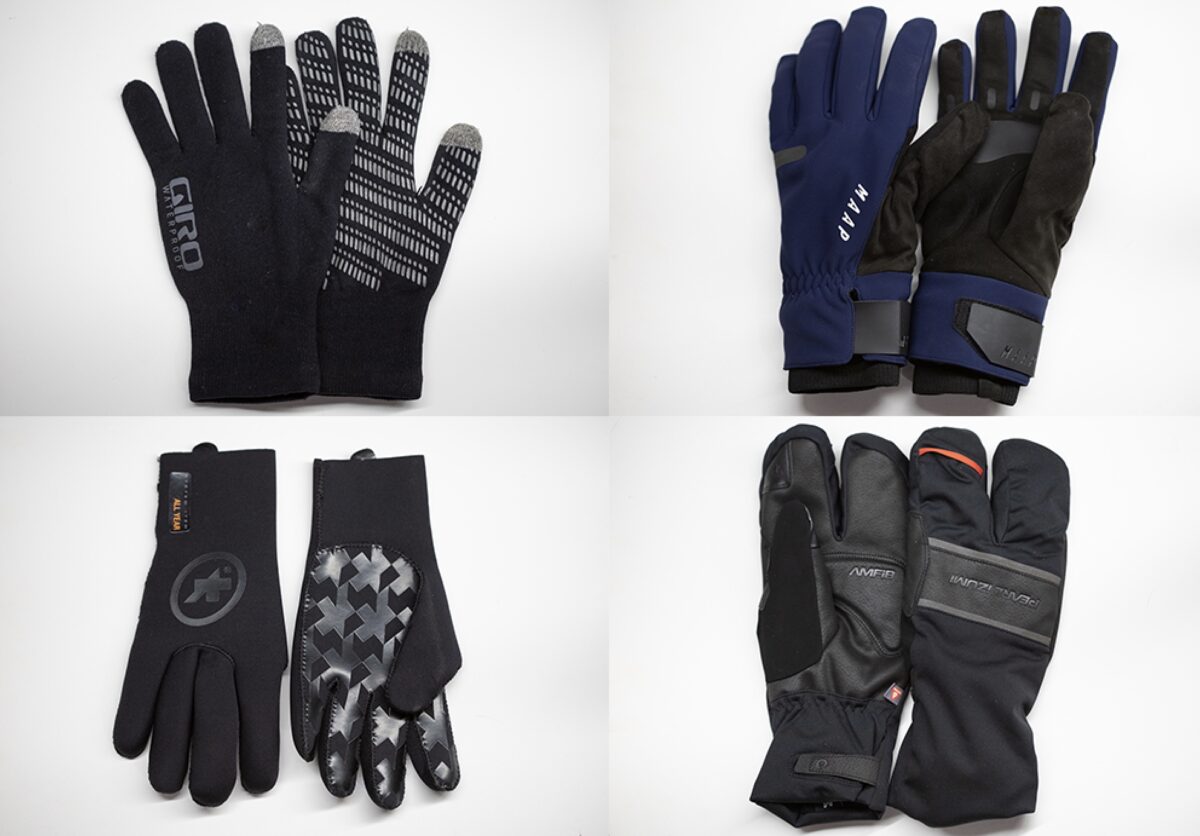
As I said, this article covered a very particular type of glove. It’s not the only option out there though. Sticking to five finger gloves there are also deep winter options. These are warmer and bulkier with a price to reflect the extra engineering. Expect to pay around $150 for a deep winter cycling glove and don’t expect better wet weather performance, just better cold weather performance.
Another option is to go for a mitten or lobster type glove. If you think you need more warmth and are willing to give up dexterity, there are a number of options on the market that group 2-3 fingers together. The pricing stays in the $80-$100 range and they are definitely warmer. It is more of a hassle to use your hands though and you still get about the same wet weather performance.
If you want to keep your hands dry, neoprene gloves are available for cycling and they do indeed work great in wet weather. What they don’t do is work in cold and wet weather. At 50 degrees, neoprene gloves are awesome but at 40 they don’t work. If we get more wet, cold, weather this year I am going to try neoprene gloves inside of deep winter gloves, but for now my advice is to avoid them.
Another radical idea is something like Bar Mitts. I’ve never used them but the few people I’ve discussed them with tend to rave about how awesome they are. My guess is that if you can stand the style they probably work really well. I hear Birkenstocks are comfortable too.
Waterproof knit gloves are a favorite around here. Popular options come from Giro, Sealskinz, and Portland-based Showers Pass. The designs are all similar. What you get is what feels like a wool knit glove but it’s a three-layer design with a membrane in the center. Like all softshell cycling garments they feel amazing but will become waterlogged with time. More important to this article though, they aren’t really appropriate for December/January riding as they aren’t warm enough. I expect some pushback on that statement but they don’t work for me and they aren’t designed to work for winter riding. Save them for fall and spring and you’ll love them!
Winter gloves are an ever evolving exploration. After years of riding in the cold I still see new options and find new solutions. This year I tested more gloves than ever and I still feel like there are more to try. Let me know in the comments if you have a favorite glove that works for you.



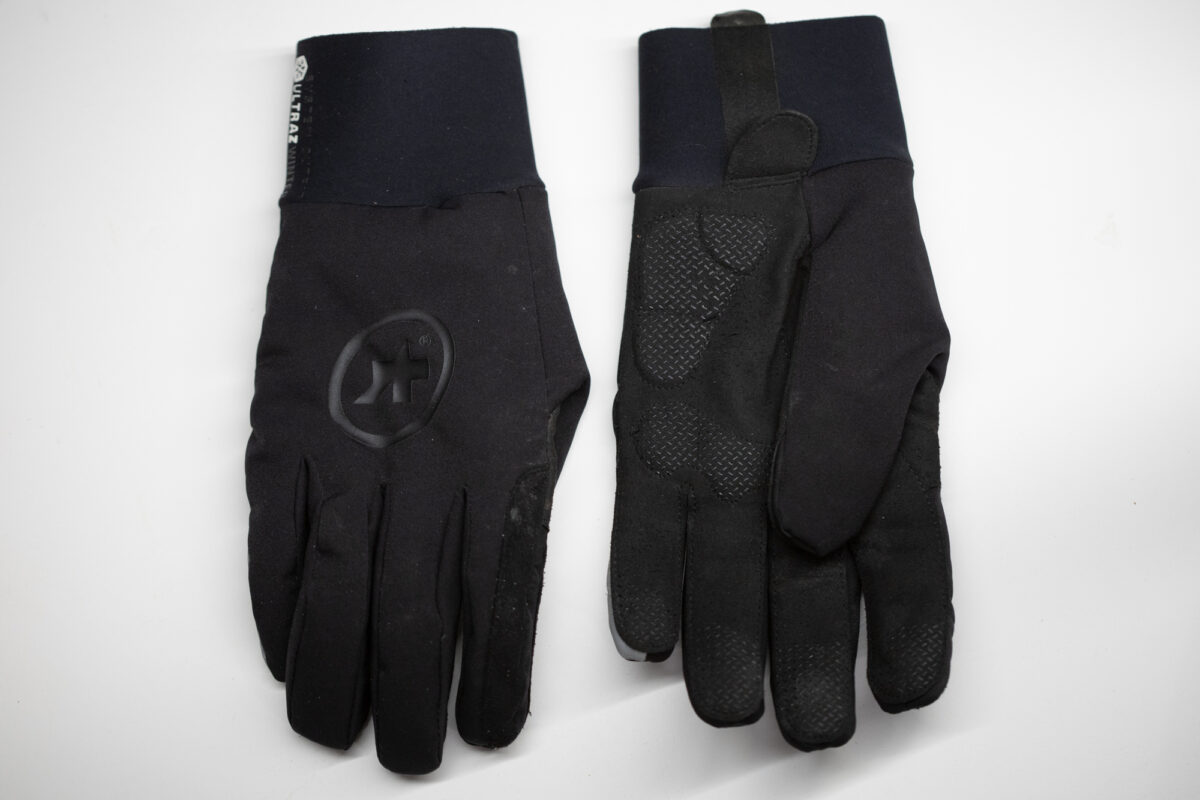
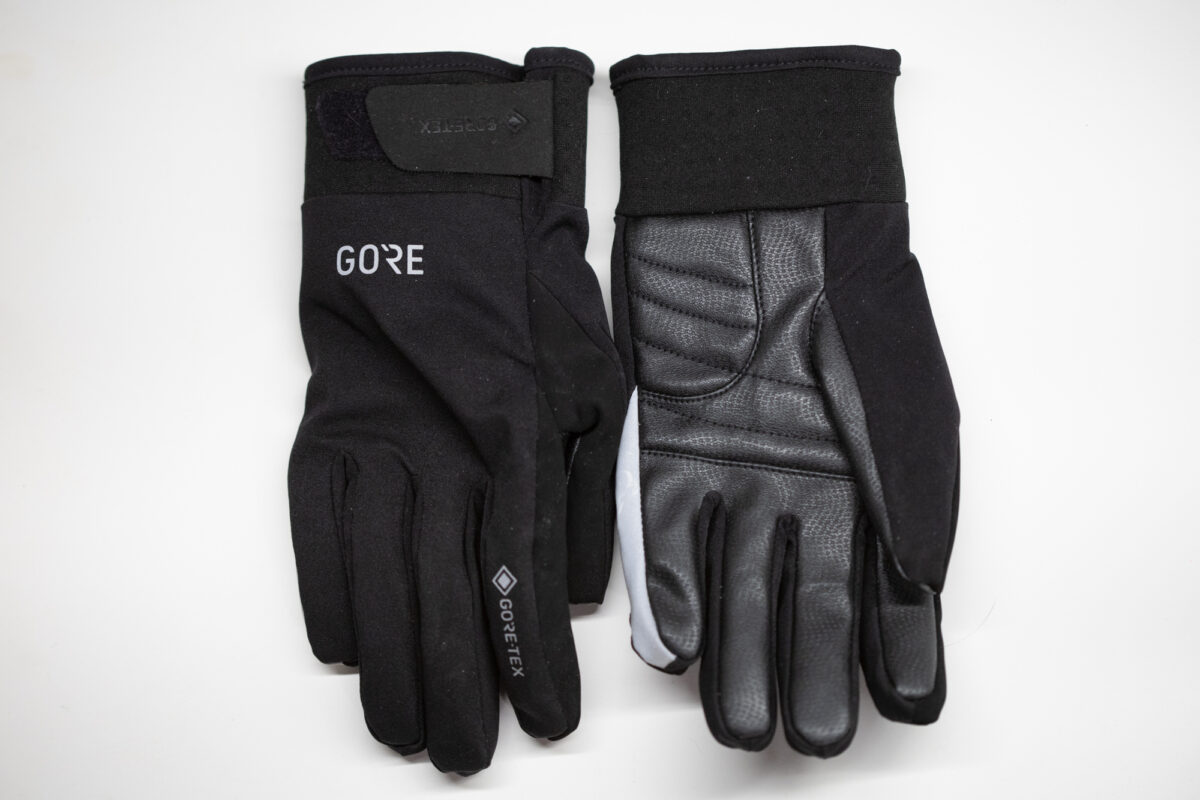

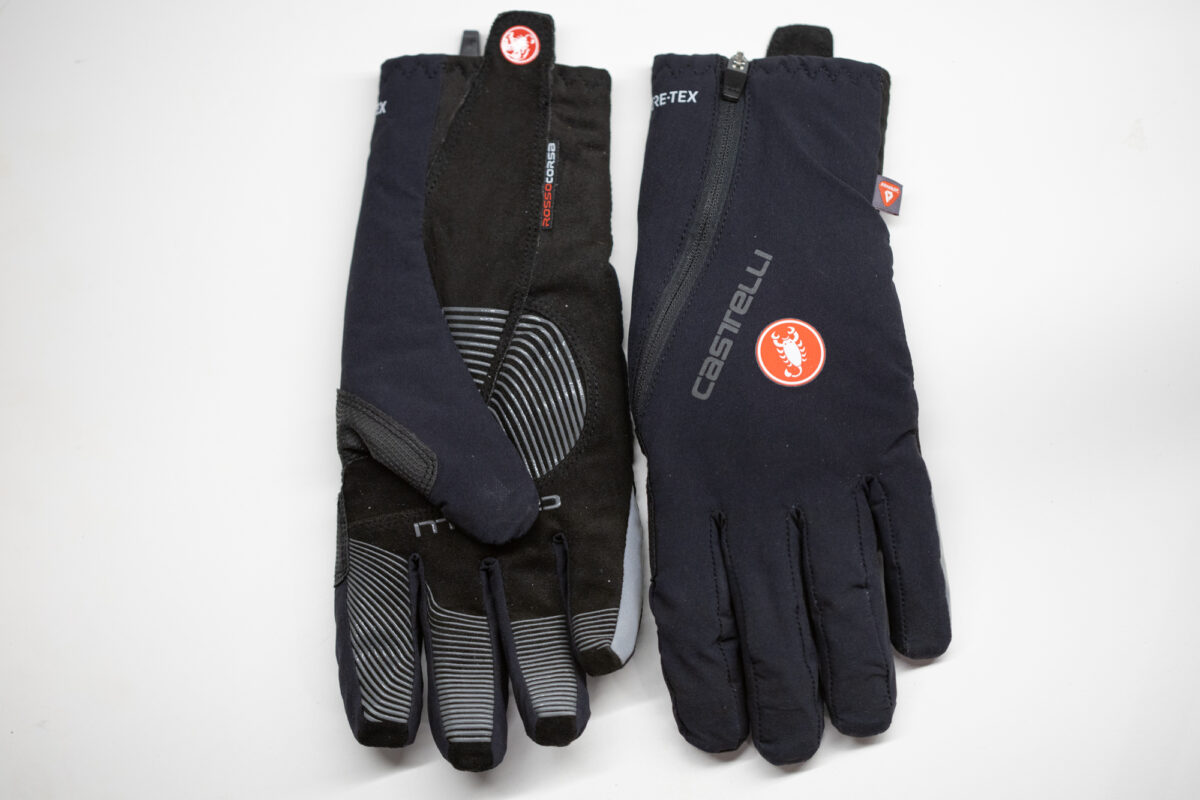





Thanks for reading.
BikePortland has served this community with independent community journalism since 2005. We rely on subscriptions from readers like you to survive. Your financial support is vital in keeping this valuable resource alive and well.
Please subscribe today to strengthen and expand our work.
One company I strongly suggest checking out (I first heard about them from the OMTM group) is Glacier Glove. I’ve used their neoprene ones and they have great dexterity and warmth and are very waterproof. They don’t breath at all though, so that’s an issue https://glacierglove.com/
I think wool socks are always your best bet: your socks are gonna get wet anyway (from within and without), so you may as well have the best chance of keeping as much heat as you can. Those medieval shepherds knew something about staying warm in the wet and cold weather.
Sheep stand outside all day in the cold rain. They knew something about it too. Wool has the best thermal and smell properties of any technical fabric I use.
The only thing it’s not superior at is wind blocking and abrasion resistance.
I use their stuff for winter paddling. The curved fingers are good for grip.
They’re fine for normal winter weather here and are great for cold rain. I wouldn’t use them for serious cold though they’d probably be good even then for commuting distances.
For cold wet stuff, neoprene is my favorite. It’s effective, reasonably durable, and functions well when damaged. It’s a miserable material to wear if it’s not cold, and it’s also bulky/heavy so it’s not as great if you have to be in conditions that change significantly.
Pogies.
It’s seems that most of these gloves do not have a large and highly-visible reflective area (except, perhaps, the POC glove). I make many left turns in peak-hour traffic at night and impatient SUV/truck/(car) drivers will sometimes attempt a pass into the oncoming lane while I am making a left turn. This is a very high risk situation so I view a large reflective band on my glove as essential left-turn signaling safety gear.
An example of one of the gloves that I have stockpiled that has a large and highly-reflective area:

I recommend you get a turn signal for your helmet. There are a lot of ’em on the market, including ones that are integrated into the helmet flasher.
I don’t wear bike helmets.
I’m personally a fan of the showers pass crosspoint knit gloves. Only gripe is they don’t have capacitive touch screen patches. But they are relatively cheap, and they work great in Portland’s climate. I’ve lived and biked year round in places that get really cold. I would not use them there. But if temperatures rarely dip below freezing, the cross point is more than adequate.
I was really surprised to find no discussion of Shower’s Pass’ 9 different glove options in the article. They’re pretty great.
I specifically mention the showers pass knit gloves. Great gloves that a lot of people love but aren’t warm enough for me when it’s December/January. I love them in the spring and fall.
Bike Gallery put me onto the Endura Strike glove when my knit Showers Pass gloves (which are wonderful, waterproof, and warm down to about 40) are not warm enough for colder rides. Endura is a Scottish company, so these are designed for weather similar to ours (dreich). They have been great for rides in the 25-35 degree range, around 3 hrs, and in rain or dry cold.
The necessity of the gloves to keep hands dry is overblown. (Especially at $160 a pair!). Wet but warm are happy hands. I am quite satisfied with Head “Runners Gloves “ that I bought at Costco for $12.
Just about every Sunday ride I did through December was right around 32 degrees and constant rain for about 7 hours. I’ve experienced frost bite in the past and I’d rather not revisit that experience.
For every rider who is spending 7 hours in 32 degree rain, there are probably 50 riders who ride in 40 degree showers for a couple of hours or less. Our gear should fit the need. Being dismissive of inexpensive, functional products effectively disregards the needs of a good portion of this blog’s readership
Hi Granpa,
Where was Josh dismissive of inexpensive gear? I think he’s been open about what type of riding he likes to do and why he focuses on certain types of products and not others.
Fair enough. Josh sees cycling through his lens and I see cycling through mine l . Both are valid
Right. And my intention in leaving that comment is to remind folks that I don’t have an unlimited budget to just hire everyone to cover every angle of everything. Let’s realize that not every piece of content we publish will be for every type of bike rider. It’s also important for folks to keep in mind that BikePortland readers come from an extremely diverse set of viewpoints! I’m trying to give people from all types of backgrounds something they can relate to on a daily basis. On that note, I’ll definitely try to feature more types of products from other reviewers. If you’d like to see more reviews and more voices here, one great way to make it happen is to support us with a financial contribution and/or become a subscriber.
BikePortland offerings are only limited by our budget. We can do so much more with more support. Thanks!
I apologize if that came off as dismissive. Not my intention. I realize that most people don’t do the kind of riding I do. My hope is that when I put a product to the test in a more extreme way that then applies back to those who use them in less demanding situations. In this case, if I can find a glove that keeps me warm for 7 hours when it’s 32 and raining it’s going to be a good glove that I can whole heartadly recommend for more common 3ish hour rides when it’s a bit warmer and a bit less rainy. As far as I see the market, most of these gloves are kind of the same and that’s confusing for people. Everyone wants to know if they should spend their money on this glove or that. Then when they make a choice they find it fails and they think maybe they should have bought the other one. Having used all of them, it doesn’t much matter. I do think most people who ride for a few hours, or more, in the winter should have at least one pair of this type of glove but there’s no need to obsess. Look for the one that you find on sale and if you want to ride for more than 2-3 hours then buy a few pairs.
Granpa, methinks thou doth protest too much. I’m no elite cyclist and my longest winter rides are rarely longer than three hours, yet cold hands are a serious problem for me, even at temps around 40. I’ve been looking for a cold-weather glove that works in Portland’s wet wet climate for years, so I’m really grateful for this post.
Glad to help. I said it another comment but I think the one piece of advice I’d give is to find a pair of gloves on sale and buy multiple pairs. Swap every couple of hours and you are good.
I used to fret about this, but now if it is colder than 40 degrees and raining, I just head to the trainer and bang out a hard workout. No sense in dealing with the weather much less the road conditions and jeopardizing being able to ride when it is actually enjoyable.
Yeah, the trainer is definitely a valid way to handle the situation. I’ve been doing 100 miles every weekend for the last few months and it’s tough to do 7 hours on the trainer. Not impossible, I’ve done it before, but tough to do all the time. I definitely spend time on the trainer during the week though.
I almost never ride a bike because it’s enjoyable. For me transportation cycling is a daily chore like hand-washing dishes or vacuuming.
Seems like a bummer. I’m genuinly curious, why is it such a drag?
The absence of enjoyment does not necessarily mean that it’s a drag. Cycling is just the way I get from point A to B, not something I do for enjoyment or leisure. In fact, I almost always listen to a podcast, news, or music while I ride because I find riding to be boring.
I’ve been using a pair of Craft ‘lobster’ gloves with wool liners inside…toasty fingers!
Longer glove which widens at the base so it covers your jacket cuff keeping in more heat plus velcro to close.
Not completely waterproof and they do breath.
Thanks for the reviews. It’s really nice to see BikePortland covering products as well as news.
I make a distinction between riding and commuting gloves. For winter commuting in the rain I prioritize dry over warmth and fit, so I have some insulated rubber gloves I found on Amazon for < $15.
https://www.amazon.com/Chemical-Resistant-Wells-Lamont-194/dp/B000BPUFFO
For longer rides I have an assortment that have been collected over the years. I’ve had good luck with PearIIzumi 5 finger and lobster style gloves. For me on cold rides lobsters are essential.
On a rapha festive 500 ride in 2019 I was following a couple and when the rain got really bad they pulled out pink dish gloves that matched all their rapha gear. It was pretty epic.
I’m sorry that Bar Mitts don’t match your bicycling outfit, but glad that you mentioned and linked to them. They are a total game-changer for riding in wind, rain, and cold. And, they’re cheaper than any of the gloves you reviewed.
Just a little joke to lighten the mood. I try not to take myself, or my riding, too seriously.
I used to regularly ride for hours in temps way below freezing. Gloves are just the wrong tool for the job if it’s truly cold, though they’re probably fine if you’re not out that long.
I switch to lobster mitts once the temps get sufficiently low, the mid 20’s for me. At some point, adding chemical warmers helps.
Note that fixing flats and other simple tasks become way harder when you can’t feel your fingers and plastic things become brittle.
Trying to keep hands dry is a waste of time. Normal riding position sends water towards your hands, and the same magic that keeps water out also traps water in your gloves.
I’ve been a GoreTex product tester for 14 years and while I swear by some of their stuff, I neither use nor recommend waterproof gloves for cycling.
I had a fascinating conversation with Gore related to my review of their gloves. They absolutely guaranteed that they were fully waterproof and wanted to see the gloves if not. Getting to the bottom of it, the membrane was guaranteed waterproof but the glove would still end up soaking wet. I’ve yet to meet a glove that keeps hands dry so it is what it is.
Yeah, when the surface layer material of Gore Tex fabric wets out, moisture will eventually get wicked through the membrane. Even though you could spray a hose at a Gore Tex membrane without any water getting through, that doesn’t mean that it will still keep protecting you when the garment is totally saturated. And if you are sweating a lot in high output aerobic activity, your sweat will accumulate faster than it can evaporate through the fabric. So you end up getting moisture coming from both sides, eventually.
Moisture shouldn’t wick through the membrane — that’s a sign of product failure.
However, all kinds of things go wrong once it wets out. The cold water on the outside basically clings to you so you lose all your heat through conductive transfer as like you would if you’re wet even though you’re dry. The breathable properties diminish dramatically so your warm moist air won’t get through. Even if you’re not technically wet, you’ll feel like you are and have most of the same associated problems.
For high output stuff, you need to dress light — the only GoreTex technologies I use for cycling are their ShakeDry and Active even if temps are in single digits. Anything else is way too heavy.
Most Portland cyclists way overdress — nonintuitively this is a great way to freeze. Once you get wet with sweat, you’ll lose heat like crazy both via conductive transfer and evaporation. There is a reason mountaineers in much colder and more extreme conditions wear uninsulated shells.
The Idro Pro 2 and 3 from Castelli are both in my cycling garment trunk. Shakedry is amazing but there’s no way it will work for me in deep winter. I’ve been using an Assos Ultraz winter jacket with an Equipe RS rain jacket over it and it’s worked for me. So far January has been a bit more mild so I’ve been leaving the hard shell at home and switching to another Assos jacket.
Thanks for this outstanding review of winter gloves. I recently acquired some Xincshow (or Xingshow) gloves, made in China. They are supposed to keep your hands warm even when wet, but my experience of using them during the very cold week between Christmas and New Year’s was very similar to yours: once your hands get wet inside the gloves, it’s pretty much game over. I hadn’t thought about carrying several pairs of gloves (to change into a dry pair) so I’ll try that next time.
It’s the only thing I’ve ever really found that works. Plan for a new pair every two hours.
Nothing is better than putting on a pair of fresh, warm gloves on a cold, wet ride.
I have a set of dissent 133 gloves and really like them. It’s a layered approach to gloves and I think pretty effective. Putting on 2 warm layers and waterproof layer on top of that has kept my hands warm on most of my really cold road rides.
https://www.dissent133.com/collections/cycling-glove-systems
I have those sitting in my house waiting for a review. They came to me after I wrote this article but I think they are a strong contender. Another brand actually suggested that totally sperating the waterproof layer was a good idea and that’s what they do. Now if it would only start raining again so I can test them properly.
I’ve been looking for rain over-mitts with palm slits for sticking out liner-gloved fingers for temp & bike controls. I have some old neoprene flip mitts but haven’t found a good replacement.
I didn’t read all comments so maybe this was mentioned. Go to a hardware store, buy big rubber gloves (some are lined, or you add the liner) and happily save lotsa money. The thick rubber has no seams, blocks wind, and you stay dry. Downside? Not good nose wiping material, it just smears!
What I’d love to see is a review of gloves under $20. There are many “work” gloves that are functional and cheap, because workers can’t spend $90 a pair. Bike glove prices are absurd.